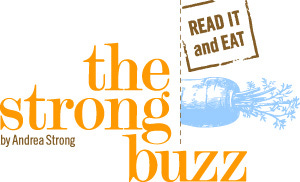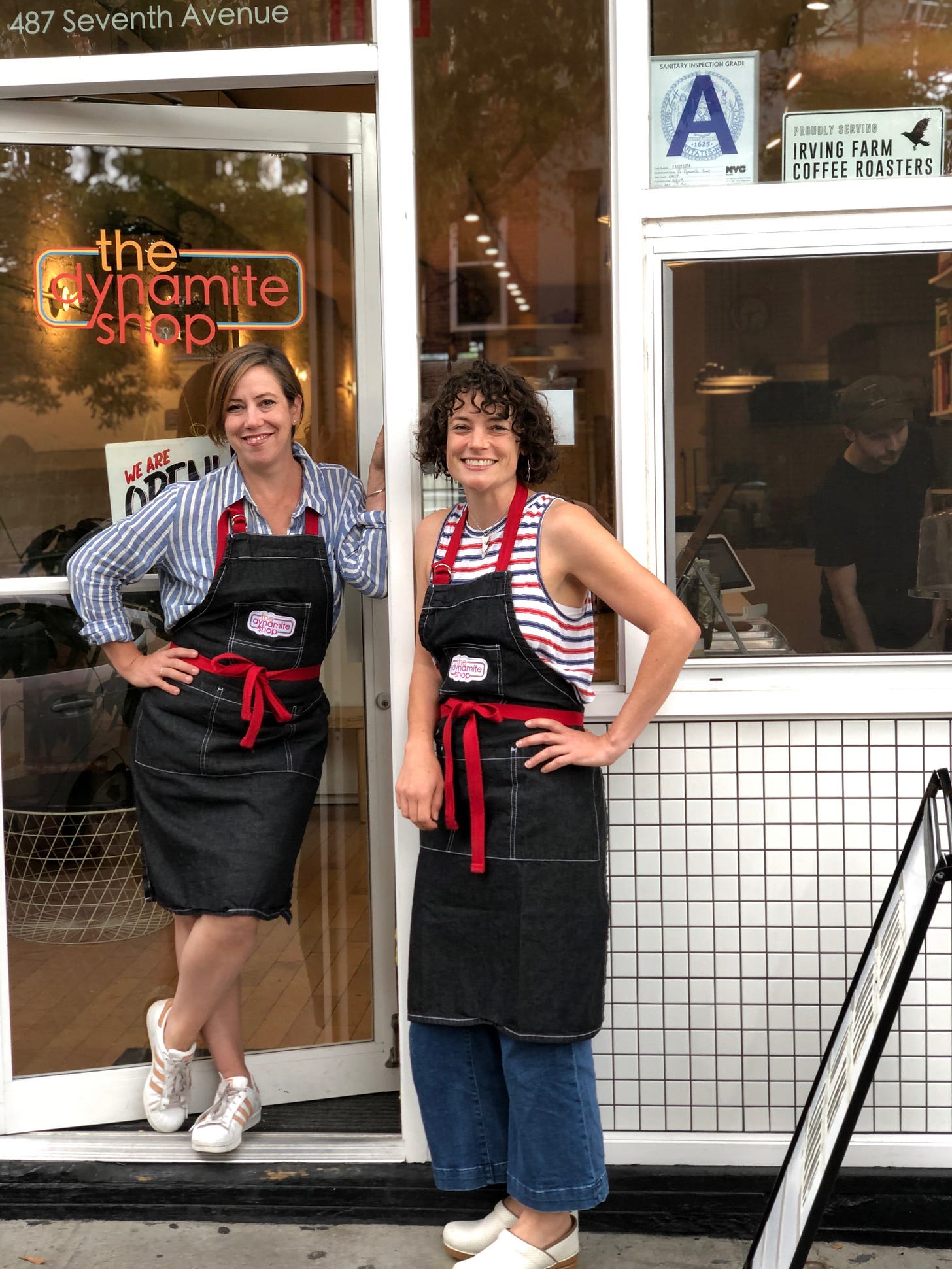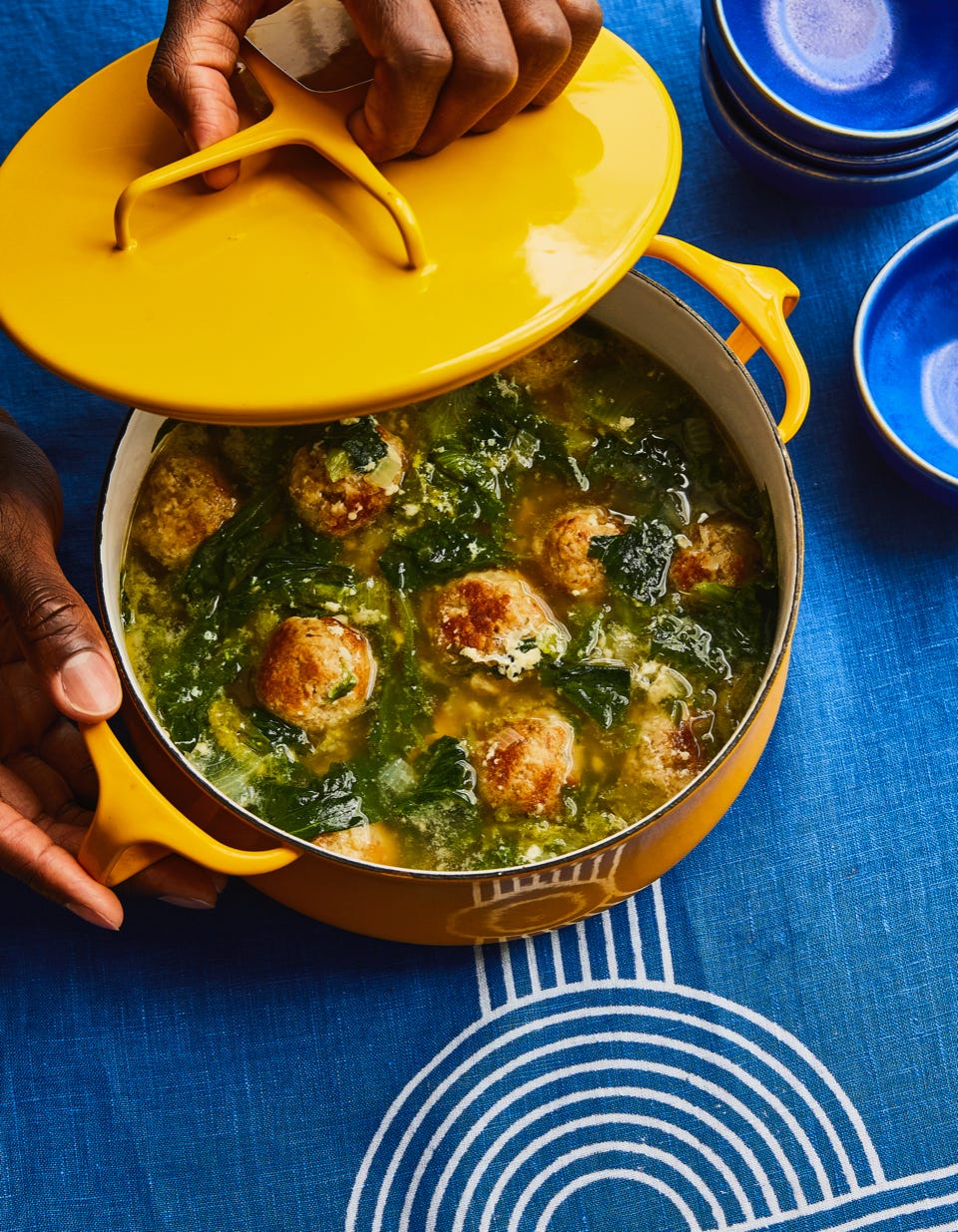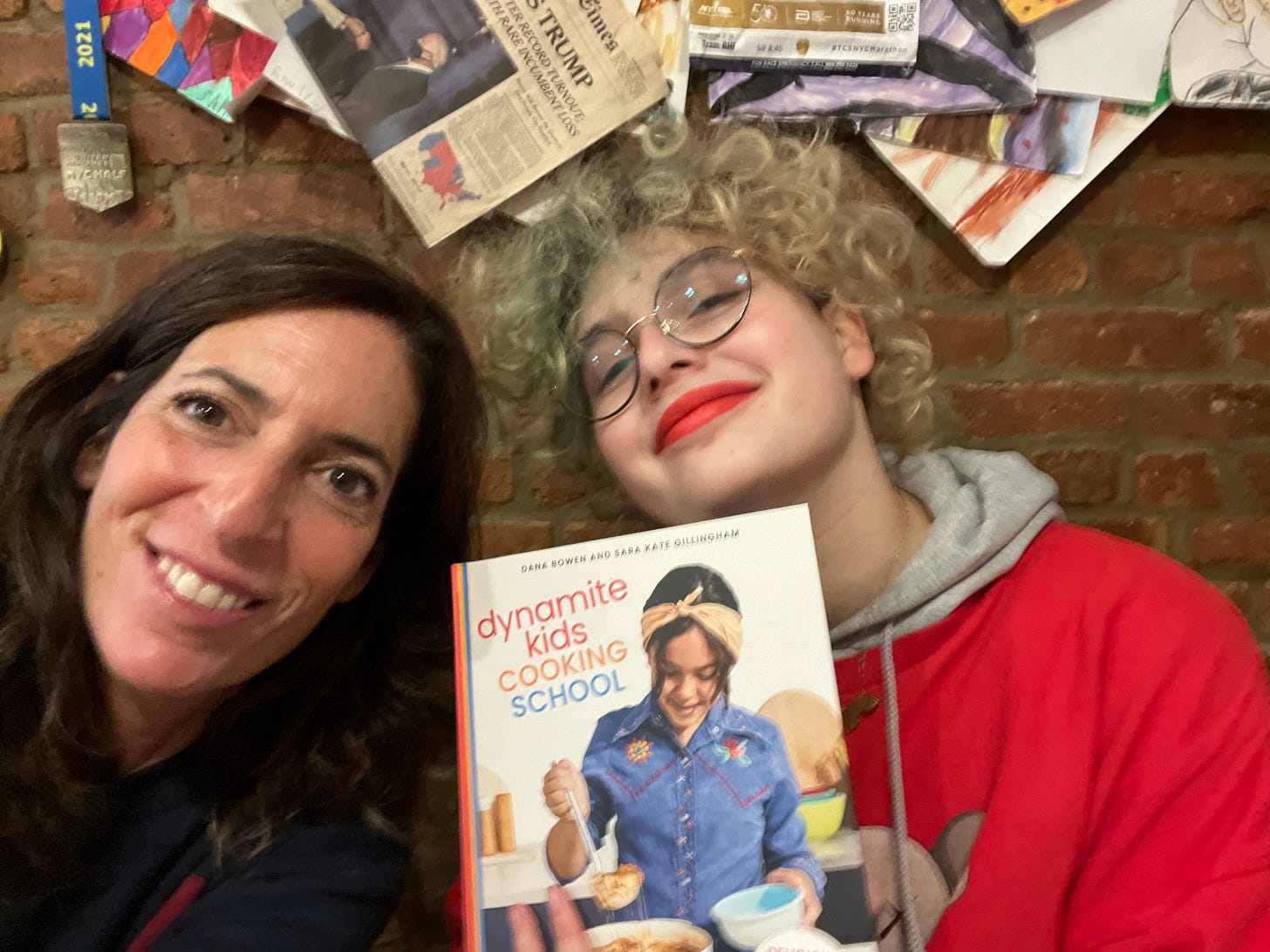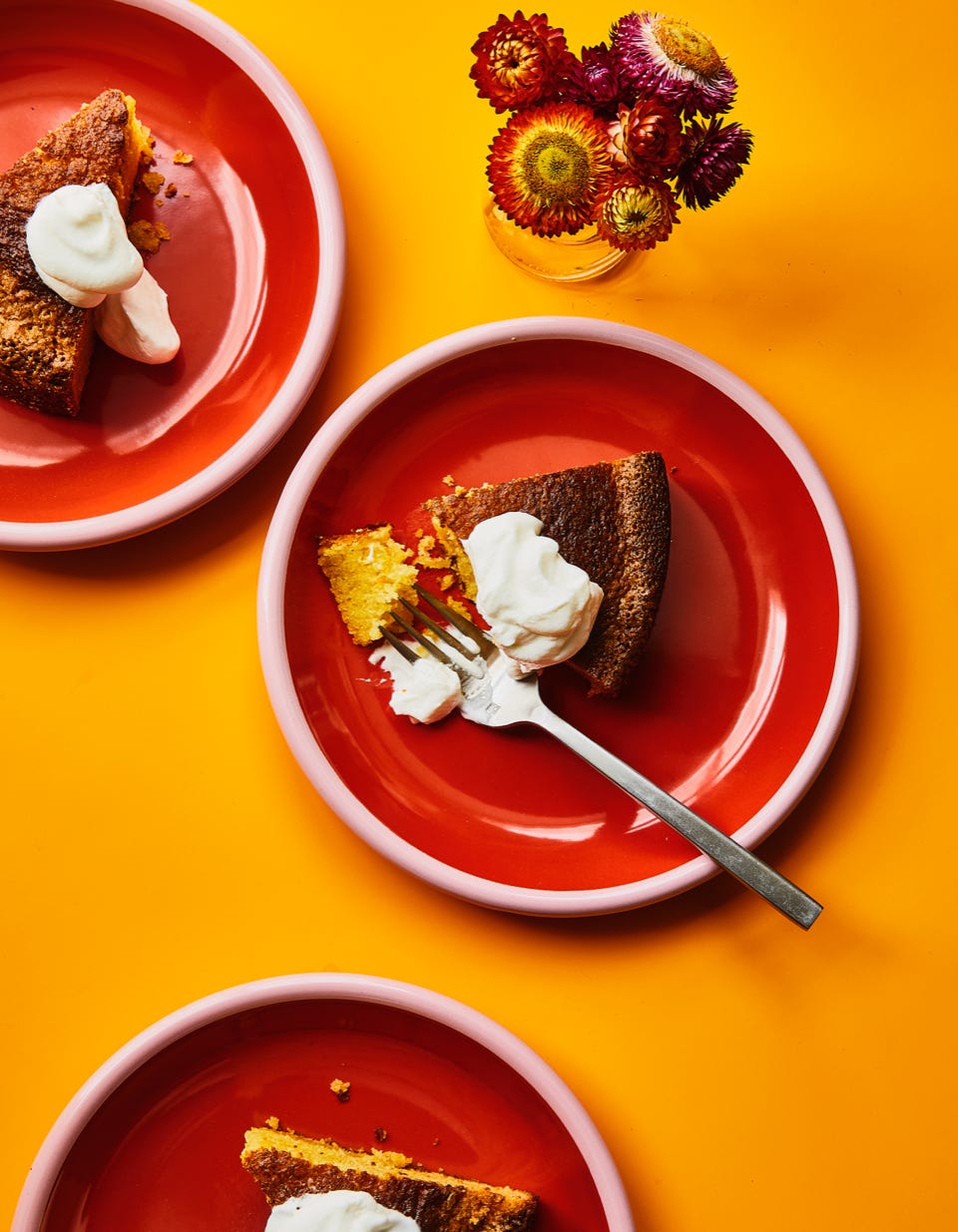Want your kids to learn to cook? (and love it!)
Get this book...also, the way to get your silent teen to open up may be making dumplings together.
Back in 2018, longtime friends and food journalists Dana Bowen and Sara Kate Gillingham opened the Dynamite Shop cooking school in Park Slope. The concept was this: teach tweens and teens how to cook and empower them to learn to feed themselves and their families. Their tag line was powerful: DELEGATE DINNER!
At the Dynamite Shop kids would learn Americana classics like mac and cheese, chicken pot pie, and buttermilk cupcakes, but also enchiladas, laab, ramen, and pho. Each lesson began with the culture and history behind the recipes. My child could not get there fast enough. Eiji went once a week on Tuesdays with a few friends from school, and every Tuesday night, he brought home dinner that he had made that afternoon, which we shared with the families of his friends back at our apartment.
These were some of the most fun dinners we’ve had as a family – weekly mini-Thanksgivings of sorts with parents and kids together, passing plates, talking, sharing stories behind the recipes, and funny moments from that afternoon’s cooking class. Over the 8 weeks of class, we shared pan-fried dumplings and steamy bowls of ramen, fresh kale pesto pasta, comforting pots of Italian Wedding Soup, big casseroles and buttery hand pies. The best part was that the table was full of food, friends, and conversation; oh, and also I didn’t have to cook once a week. So yeah, it was dreamy.
Now Dana and Sara Kate have poured all those recipes, lessons, and fun into the Dynamite Kids Cooking School, a fabulous cookbook published last week. I love this book so much! It’s perfect for anyone with a kid, even if that kid doesn’t know they want to cook yet. And even if your kid is not an “adventurous eater.” Perhaps the book is especially for those kids. Because it makes cooking fun, collaborative, and exciting. It makes cooking part of your life, and it opens up a world of food and history and most importantly, togetherness. You can’t be on a screen when you cook. You are present. You are together.
I spoke with Dana and Sara Kate yesterday about the book and we touched on a lot – the right age for this book, how to handle cleaning up, why making dumplings may be the way to get your silent teen to open up, and the best and easiest cake you’ll ever make. I’ve also included a simple and wonderful recipe at the end of this post. I hope you enjoy our chat and this book as much as I do! It’s a great gift, even if it’s to yourself!
Andrea: What ages are the best for this book?
SK: Depending on how much parents are helping as young as 4 or 5 years old. For kids cooking independently, you have to be able to read, so depending on the kids, maybe 7 or 8 and up. We think it’s also an adult book. It can be a book for a 15 year old too; mine wouldn’t be into it because she doesn’t want to cook now, she just wants to be with her friends.
DB: I think for older kids who love to cook it’s a good choice, along with something like the Joy of Cooking or something more Tik Tok or modern. But we did create it as a book that kids can dip into for easy familiar things like Buttermilk Cupcakes or Mac and Cheese. And with each recipe we pull out a lesson or lessons so that they learn as they go along. And if they read the book from start to finish it’s really a full cooking school type of program that builds on the learnings from start to finish.
SK: It’s kind of a sneaky book in that it has cupcakes and mac and cheese but then they can also learn to make porchetta. A family might want to do that – maybe they have had it at a restaurant and they think let’s try that at home. So the book lures them into trying new things, like Gumbo, Laab, Ramen and Pho. There are great lessons there, and regional specialities.
Let’s talk about the recipes you included. How did you come up with the list? Any favorites?
DB: Most of the recipes are recipes that we cooked for our families for years, so we like all of them. But the porchetta is one of my faves because I have been making it since I was in my 20s. It’s a dinner party dish. It’s beautiful. It’s a roulade and you learn about the herb garlic blend, or use pesto. There are a lot of lessons in the recipe.
SK: For me it’s the Italian Wedding Soup. This was what I ate as a baby. Apparently I loved it, but I also had an allergy to something in it, and as it would flow down my chin in the high chair and I would get a rash, but that’s 70s parenting for you. My mom was like she loves it, she’s eating it, who cares about the rash! The recipe is so easy and there are lots of lessons in that one for making meatballs and the soup.
I also love the orange olive cake that’s so easy it’s almost like a dump cake. I make it constantly. I made it for Dana’s April 2020 birthday. We left it on her porch. It’s something so easy for kids to do and they can decorate it, and an adult can make it more sophisticated. That’s why we wrote that book. Sure you can put faces on it, but there is a lot of food that kids and adults can like together and it doesn't have to be dumbed down.
DB: Kale Pesto (the recipe is at the end of this post) is another one of my favorites because you can use it on so many things. One thing we didn’t touch upon is that this book is all about teaching kids not to follow recipes to a “T,” but to understand the recipe as a template. We want kids to customize the recipes to their taste. The pesto you can mix up with herbs or nuts, and the Chicken Kebabs too. They are a great example we offer a few different ideas for spice blends and we encourage kids to try to do different things and customize to their taste
SK: There are a lot of options for customization, and it becomes a workbook so you can do what feels and tastes right to you.
DB: I feel like when kids are told to do it this way and it may set them up for perfectionism. But when you say make it your own and then it empowers them and then they feel so good they invented something. Cooking is about inspiring creativity and we saw them do that with dumpling shapes in our classes. They would make rocket ships and circles and all sorts of crazy shapes and they would not line up right on the sheet pans, but it was ok. You have to let go of what you want to see happen and let them create.
DB: The other day I was looking through my phone photos and I came across a video of our kids making dumplings at the Dynamite Shop. There were six kids sitting together, and they were folding dumplings, side by side, quietly chatting with each other and laughing as they are doing this manual process. And this is what it's all about. Sitting around the table with your grandma or neighbors or friends, and working together to make something you will share. That part of cooking is nourishing and can feed the soul.
Andrea: Yes, I remember Eiji having friends come over to make dumplings and how much fun they had sitting together, passing the fillings around, stuffing the wrappers, and pinching them, and then eating them together. And these are recipes that are that, like making meatballs or an assembly line for enchiladas or tacos, make those memories.
SK: I think for me, particularly parenting a teenager, I don't cook with my daughter anymore, but there are times when we do these more manual assembly projects together. And that is where you can perhaps have those harder conversations and ask questions about their struggles socially or have a talk about drugs and alcohol. When you are sitting together, folding dumplings, that can serve as a bridge, as a way in. So cooking is there for you at all developmental stages. You can have this book with you from age 5 up through an empty nest, because adults can cook from this book too.
DB: Yes, this book was written for kids and families, and mainly to have the kids use it for their guide and inspiration. Our Cooking with Dynamite newsletter that’s for the parents, and we have shared many more personal parenting stories and reflections in there. I feel like the newsletter and the cookbook sort of holds hands in that way.
What’s your safety advice to parents cooking with kids in terms of knives and using the stove?
SK: We always say parents know their kids best. So we can’t tell you what age or height to leave kids alone in the kitchen. You know your kids best, but I would say there is no one under seven years old who should be left alone in the kitchen. Kids have different abilities and attention but the idea is to do stuff with your kids. It's empowering that they can do dinner on their own but if they are just learning you should be in the kitchen with them. We don’t love kid knives. We would rather you get a small 6-inch chef’s knife and teach them how to use it safely. You can get the knife protection gloves to wear on the other hand, so kids feel safe and they can hold the knife and practice without worrying.
I have a lot of friends who say, “Andrea, if you want to cook with the kids, do it at your house because I don’t want a mess to clean up.” They know I’m not bothered by a huge mess. I’d rather have the experience of cooking with my kids and deal with a big clean up. What are your strategies for kids and parents to get the mess cleaned up?
SK: We believe that if you make the mess you clean it, but you have to set them up for success so that there is enough time to clean up. And you can’t expect too much. The way you clean may not be the way they clean, but you can allow them to do their best and then clean your way. If you want them to think like an adult they have to know that there’s much more to cooking than just stirring in the chocolate chips and licking the bowl. It’s reading the recipe a day or more ahead, then shopping and preparing, and it’s cleaning up.
DB: Making a mess is fine, but there is a way to cook cleaner. In the book, we teach kids that as you move through a project you clean as you go. The book also teaches kids to prep the recipe in advance, and to read through the entire recipe before you cook. A lot of our teachers at the Dynamite Shop came from professional kitchens, and we often talked with the kids about safety, cleanliness and professionalism required of a professional kitchen. And we talked about how every night you have to clean up your station before you go home. No one cleans up after you. You need to take care of where you work.
Andrea: I know it’s hard sometimes to not just say, oh, I’ll just do it because you don’t do it the way I want you to clean. And then you just shoo the kids out of the kitchen (I do this!).
DB: Don’t ever shoo anyone out of the kitchen! I’ve made that mistake too. It was early on when I was dating my husband, and I was getting frustrated watching him chop the onion. And I did just that, I shooed him out of the kitchen, instead of teaching him how to do it. And it was a big failing that I made in my 20s. It’s one of the struggles that people who love to cook have to grapple with, they want to just do it. They are cooks so they just do it and it comes naturally to them. But with children you have to realize that doing it together and teaching these skills that are not taught any more is a service to the child. It’s always better to do it together.
Our approach is always about bringing together people of all ages and empowering kids and not talking down to them. That’s a disservice. The real heart of the dinner is what happens around the stove and the table.
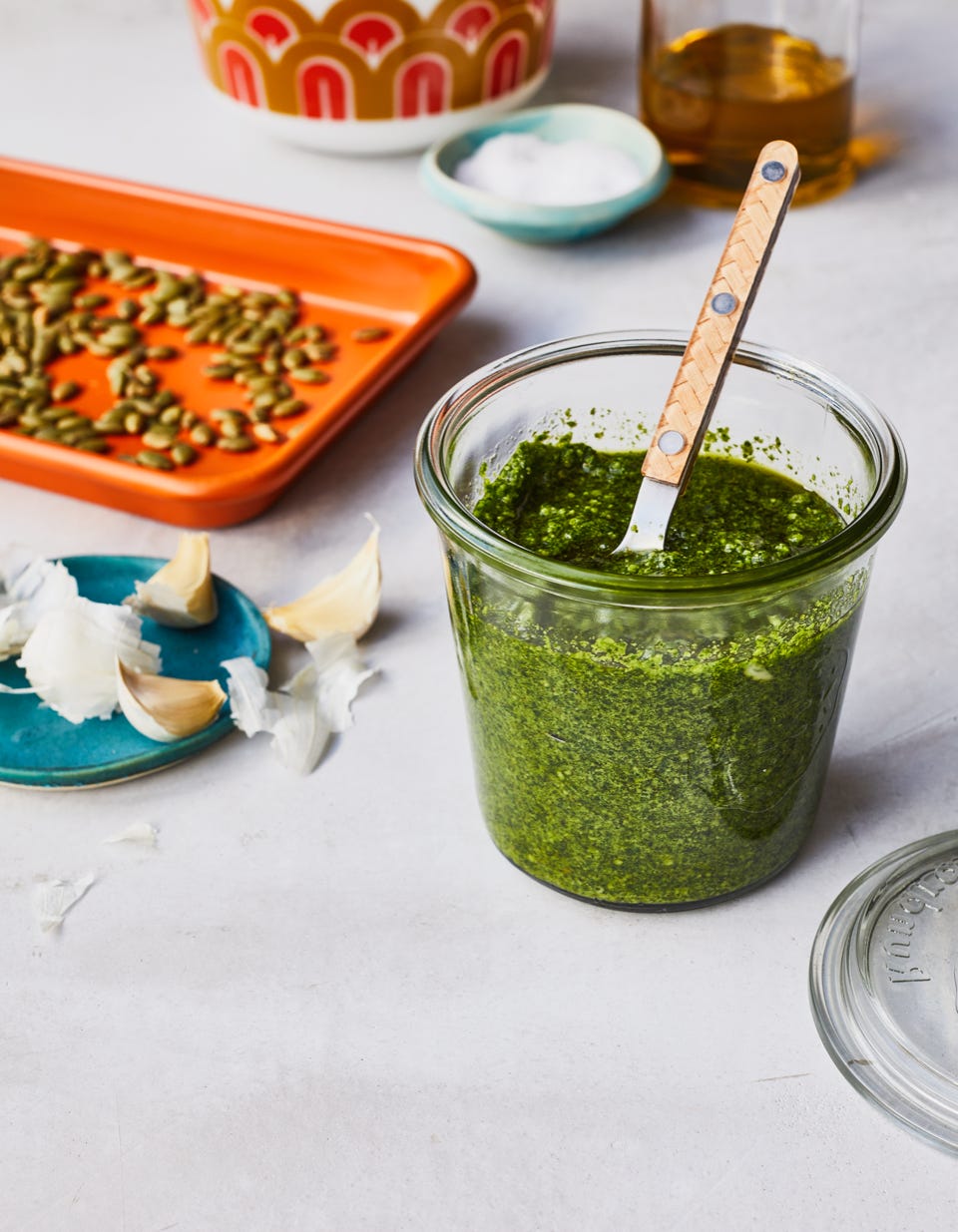
Kale and Toasted Pepita Winter Pesto
Makes about 1 1/2 cups
A truly seasonal winter recipe is not easy to come by in New York City, where we live. At some point, we get tired of potatoes and turnips and start craving the vibrant flavors of summer. Enter this completely adaptable, nut-free pesto. (We make it with pepitas—pumpkin seeds—instead of the traditional pine nuts.)
We love this rich, wintry sauce as written, but we encourage you to see this as a kind of formula that you can play with! Swap kale for basil when it’s plentiful, or spinach . . . or even roasted broccoli! Pretty much anything green works. Skip the Parmesan cheese for dairy allergies, or add more if you love it, or use any grateable hard cheese. And sub another kind of nut or seed in place of the pepitas if pumpkin seeds aren’t your thing. Soon you’ll be making your own flavors, whatever season it is!
3 to 4 cups tightly packed chopped curly kale leaves
3 or 4 medium garlic cloves
1/2 cup (about 2 ounces) grated Parmesan cheese
1/2 cup pepitas, lightly toasted (see page 280)
2 tablespoons freshly squeezed lemon juice
2/3 cup extra-virgin olive oil
1 teaspoon kosher salt, or to taste
Freshly ground black pepper to taste
1. In a blender or food processor, pulse the kale, garlic, Parmesan, pepitas, and lemon juice until combined. Drizzle in the oil while the motor is running and blend until smooth.
2. Turn off the blender. Season with the salt and pepper and adjust as needed. Buzz to combine and taste again.
Get your copy of The Dynamite Kids Cooking School Cookbook today!


